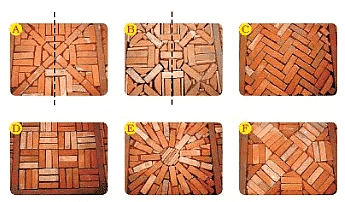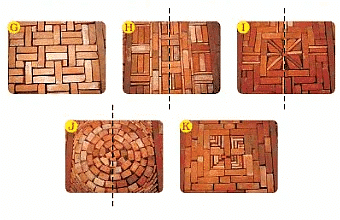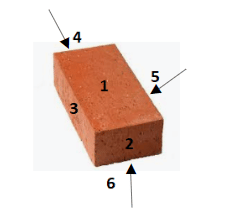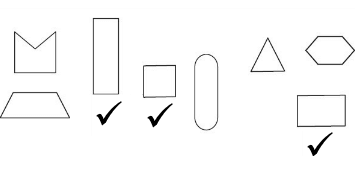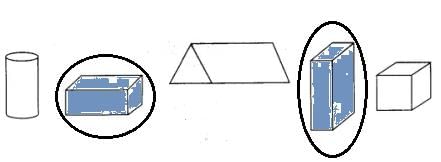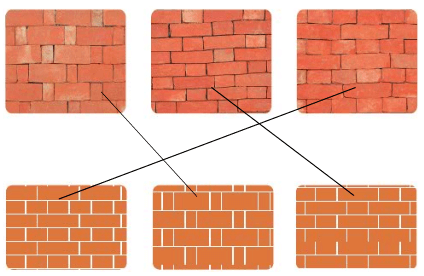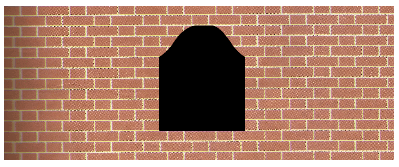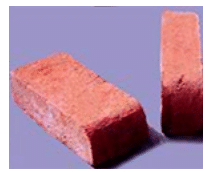NCERT Solutions for Class 4 Maths - Chapter 1 - Building With Bricks
Page No - 2
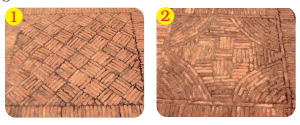
 Q1: Which floor pattern do you like the most?
Q1: Which floor pattern do you like the most?
Ans: I like pattern 5 because this seems familiar.
Q2: Have you seen such patterns anywhere?
Ans: Yes, this type of pattern is prevalent in mosques.
Page No - 3
Q1:
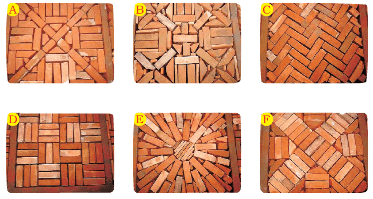
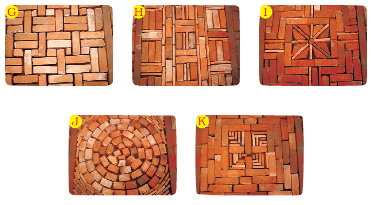
(a) Which pattern is made in a circle?
(b) In which pattern can you show mirror halves? Draw a line.
(c) Now you draw some new floor patterns.
Ans:
(a) Pattern given in figure J is made in circles.
(b) Mirror halves are those objects in which the objects are same on both sides or are mirror images of each other. We can show mirror halves in pattern in A, B , H, I and J.
(c) Some new floor patterns made of brick are given here
Hint: These are the sample Patterns.
Page No - 4
Q1:
(a) How many faces in all does a brick have?

(b) Is any face a square?
(c) Draw the smallest face of the brick.
Ans:
(a) A brick has 6 faces.
(b) No, all the faces of a brick are rectangular in shape.
(c) The smallest face of the brick is shown below:
Q2: Which of these are the faces of a brick? Mark a (✓).

Ans:
Q3: Which of these is a drawing of a brick? Mark a (✓).

Ans:
Q4: Make a drawing of this box to show 3 of its faces.

Ans: Figure of the geometry box showing 3 of its faces.
Q5: Can you make a drawing of a brick which shows 4 of its faces?
Ans: It is not possible to draw the figure of a brick that shows 4 of its faces on paper.
Page No - 5
Different Wall Patterns
Q1: Here are photos of three kinds of brick walls. Can you see the difference in the way the bricks are placed?

Ans: The arrangement of bricks is different in all the walls. Combination of different faces is shown in all the walls.
• Now match the photo of each wall with the correct drawing below:

Ans:
Hint: The arrangement of the bricks in all the three cases is different. The answer to this part of the question may vary from student to student.
Page No - 6
Q1: How many different ‘jaali‘ patterns can you see in these two photos?
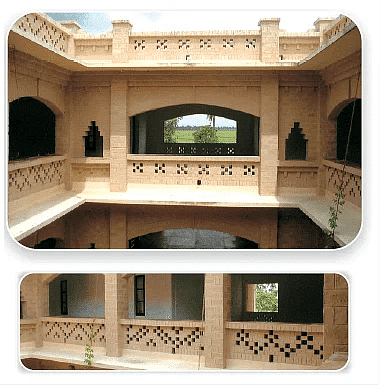
Ans: There are five different types of ‘jaali‘ patterns that can be seen in the above two photos.
Page No - 7
Q1: Now colour some bricks red and make your own ‘jaali‘ patterns in the wall drawn below.
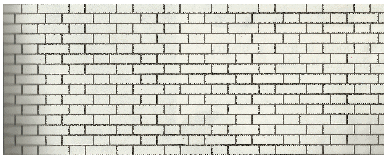
Ans:
Hint: The answer may vary from student to student, based on his/her observation. It is highly recommended that the students prepare the answer on their own also.
Q2: Now draw some jharokha patterns on the wall here. You can shade it black.
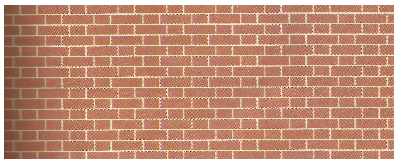
Ans:
Hint: The answer may vary from student to student. It is highly recommended that the students prepare the answer on their own. The answer provided here is for reference only
Page No - 9
Q1: Where else have you seen an arch? ___________
Ans: We can see arches in rainbow, bridge, tunnel etc.
Hint: The answer may vary from student to student. It is highly recommended that the students prepare the answer on their own. The answer provided here is for reference only.
Page No - 10
Q1: Take one brick and measure it.
(a) Which of these bricks have curved edges?
(b) How many faces do you see of the longest brick?
(c) Is there any brick which has more than six faces?
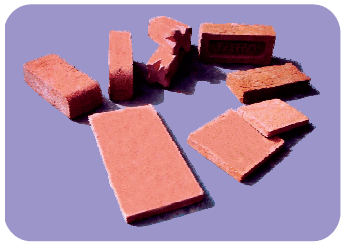
Ans:
(a) Following are the bricks with curved edges:
(b) We can see only 1 face of the longest brick.
(c) No, there is no brick with more than 6 faces
Find Out: The Size of a Brick
Have you seen bricks of different sizes?
Q2: Take one brick and measure it.
(a) How long is it? _____________________
(b) How wide is it? _____________________
(c) How high is it? _____________________
Ans:
(a) 21 cm
(b) 10 cm
(c) 0.7 cm
Hint: The answer may vary from student to student. It is highly recommended that the students prepare the answer on their own. The answers provided here are for reference only.
Q3: Muniya wants to make a wall 1 metre long. How many bricks will she need to put in a line? __________
Ans:Let the length of each brick be 10 cm.
Length of wall = 1 m.
As the length of brick in cm, the length of the wall will be converted to cm for calculation. We know that 1 m = 100 cm.
Therefore, Length of wall (in cm) = 1 ×100 cm = 100 cm
Number of bricks required to make a 100 cm long wall = Length of wall ÷ Length of 1 brick
= 100 ÷10 = 10
The number of bricks required to make 1 m long wall = 10.
Bricks and Bricks — Hot and Fresh!
Q4: Can you guess how high is the chimney here?
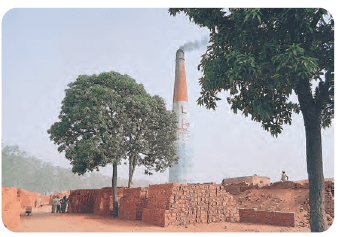
Is it:
(a) about 5 metres?
(b) about 15 metres?
(c) about 50 metres?
Ans: The chimney shown in the picture is about 50 metres high.
Page No - 11
Q1: Here are four pictures from the brick kiln. These pictures are jumbled up. Look at them carefully.
Write the correct order. ______________
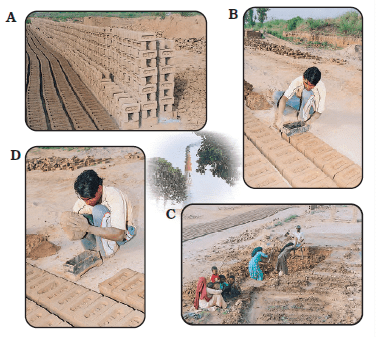
Ans: The correct order is C, D, B, A

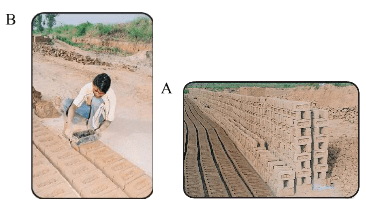
Page No - 12
Mental Math: Bhajan Buys Bricks
Q1: Bhajan went to buy bricks. The price was given for one thousand bricks. The prices were also different for different types of bricks.
| Old bricks | – Rs 1200 for one thousand bricks |
| New bricks from Intapur | – Rs 1800 for one thousand bricks |
| New bricks from Brickabad | – Rs 2000 for one thousand bricks |
Bhajan decided to buy the new bricks from Brickabad. He bought three thousand bricks. How much did he pay? ___________
- Guess what he will pay if he buys 500 old bricks.
Ans:
Bhajan bought new bricks from Brickabad.
Cost of one new brick from Brickabad = Rs 2000÷1000 = Rs 2
Cost of 3000 new bricks bought from Brickabad = Rs 2×3000 = Rs 6000
Bhajan bought 500 old bricks and the cost of 1000 old bricks = Rs 1200
We have to find the cost of 500 old bricks, which is half of 1000 bricks.
Therefore, Cost of 500 old bricks = Rs 1200 ÷ 2 = Rs 600
Thus, the cost of 500 old bricks = Rs 600
|
26 videos|142 docs|34 tests
|

